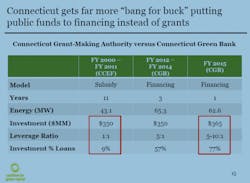Green Banks have helped solar energy attract private capital and transition away from state grants to loans. Can they help finance microgrids the same way?
Yes — it’s just not happening quickly enough.
That’s the word from Bryan Garcia, president and CEO of the Connecticut Green Bank, a quasi-state entity that uses public funds to leverage market financing for green energy.
Typically, new-to-market green energy tech relies on grants and other direct subsidies. And microgrids are still very new. But Connecticut and other places with Green Banks are strategizing the next step: How to transition microgrids into the realm of public/private loans.
It’s not as easy as it was with solar. As Garcia pointed out, microgrids create a new set of financing complexities.
First, microgrids are not one-size-fits-all, but tend to be tailored to the particular needs of customers, and sometimes must be configured to work with existing on-site energy.
Further, microgrid customers vary in terms of credit worthiness. The age and size of buildings within the microgrid may differ. And microgrids use various kinds of generation and controllers.
“No one project is the same. You are using different technologies. So how do you create a standardized process to underwrite microgrid transactions?” said Garcia, who spoke at the recent Distributed Sun 2015 New Energy Summit in Washington, DC.
Connecticut has the longest-running Green Bank in the nation. The state also led the way in creating state grant programs for microgrids. It is now readying to release its third round of grants. Garcia says he’s in talks with state colleagues about models to eventually move the microgrid funding from grants into loans.
Montgomery County, Maryland also is in search of a way to finance microgrids through its Green Bank, according to Roger Berliner, a member of the Montgomery County Council, who also spoke at the conference. The county approved a Green Bank in June.
Poor utility reliability set the county on a quest to find a better way. It noticed that a federal building with onsite generation fared much better in keeping the lights on than did utility-reliant county buildings. That led county officials to begin exploring microgrids as a possibility for public buildings.
“I’ve had discussions with major developers to see whether or not they are interested, and there is interest. So we are hoping that not-withstanding the challenges – and there are challenges – that a Green Bank will facilitate microgrids in our county,” Berliner said.
From keynote address by Reed Hundt, Coalition for Green Capital, at the 2015 Distributed Sun New Energy Summit
New York State, too, has been grappling with where microgrids fit into its Green Bank program. The state Public Service Commission has a proceeding underway that looks at how the Green Bank and other clean energy funding will be configured as it creates a more decentralized grid through its Reforming the Energy Vision.
Administered by the New York State Energy Research and Development Authority, the New York Green Bank (NYGB) identified microgrids as a technology that would benefit from its program. In its 2015 business plan, NYGB said that microgrids are commercially viable but have yet to reach scale and suffer a financing gap. Other technologies categorized the same way included biomass, anaerobic digesters, fuel cells, battery storage and electric vehicle charging stations.
So there appears to be a strong push for microgrid funding in existing Green Banks. And fortunately, Green Banks appear to be proliferating. They have already been created in such places as Connecticut, Hawaii, Montgomery County, New Jersey, New York and Vermont. Several other jurisdictions are exploring the idea, among them Rhode Island, Virginia, the District of Columbia, Minnesota, Nevada and New Hampshire, according to Reed Hundt, CEO and founder of the Coalition for Green Capital.
As communities position to attract microgrid development, Green Banks offer a financial model that takes pressure off government budgets.
“If you are a policymaker and you start quantifying how much investment it is going to take to achieve x, y and z policy, you quickly get to an end use solution that says government is not going to pay for it all, ratepayers are not going to pay for it all,” Garcia said. “You need to use the limited public resource you have to mobilize more private investment.”
What are your ideas on microgrid financing? Please post in the comments below or on our LinkedIn Group, Microgrid Knowledge.







